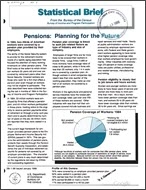
An official website of the United States government
Here’s how you know
Official websites use .gov
A .gov website belongs to an official government organization in the United States.
Secure .gov websites use HTTPS
A lock (
) or https:// means you’ve safely connected to the .gov website. Share sensitive information only on official, secure websites.
-
//
- Census.gov /
- Library /
- Publications /
- Pensions: Planning for the Future
Statistical Brief: Pensions: Planning for the Future
Statistical Brief: Pensions: Planning for the Future
In 1984, two-thirds of American workers were covered by a pension plan provided by their employers.
The ability of the Social Security system to provide for the retirement income needs of a rapidly aging population has focused the attention of many working Americans on other pension plans. This Brief looks at the extent to which American workers 25 years old and over are covered by retirement plans other than Social Security. Covered workers are those who work for a firm that offers a pension plan even though all workers may not be eligible to participate. The data described here were collected during the last 4 months of 1984 in the Survey of Income and Program Participation.
In 1984, 53 million workers were employed by firms that offered a pension plan, and 43 million workers participated in these plans. Vesting refers to the eligibility to receive pension payments either at retirement or through a lump-sum payment and is usually determined by number of years on the job; 35 million workers reported that they were vested in a plan.
The current legal framework for employer-provided pension plans is the Employee Retirement Income Security Act (ERISA) passed in 1974. This law governs the administration of pension plans, protects their assets through the Pension Benefit Guaranty Corporation, and establishes the use of individual retirement accounts for persons not covered by an employer-provided plan. The character of current plans is very much determined by the regulations laid down by ERISA and succeeding legislation.
Others in Series
Publication
Publication
Publication
Share
Related Information
Some content on this site is available in several different electronic formats. Some of the files may require a plug-in or additional software to view.
 Yes
Yes
 No
NoComments or suggestions?


Top

